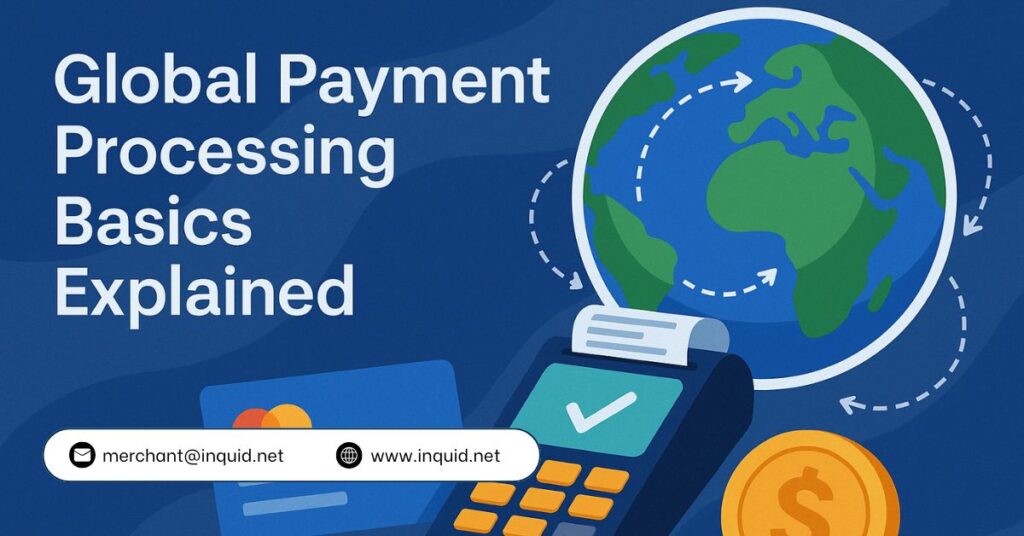
What Is Global Payment Processing?
Global payment processing refers to the system businesses use to accept payments from customers around the world. Unlike domestic payment systems that operate within one country, global payment processing handles cross-border transactions involving different currencies, countries, and regulatory environments. This process makes it possible for companies to sell their products or services internationally while receiving payments in a secure and timely manner.
For companies aiming to expand beyond local markets, understanding how global payment processing works is essential. Whether you’re an e-commerce store or a service provider, handling international payments efficiently affects customer satisfaction and business growth.
How Global Payment Processing Works
At its core, global payment processing involves several steps:
- Customer initiates payment: When a buyer chooses to pay on your website or platform, the payment information is sent securely to the payment processor.
- Currency conversion: If the customer pays in a different currency than your business account, the processor converts the amount, often applying a fee.
- Fraud check and compliance: The processor verifies the payment details and runs fraud detection protocols to reduce the risk of chargebacks or scams.
- Transaction approval: If everything checks out, the payment is approved, and the money is transferred from the customer’s bank or card to the merchant’s account.
- Settlement: Finally, the funds settle into your bank account after fees are deducted by banks and payment gateways.
Managing these steps smoothly requires a reliable payment gateway, especially when working internationally. If you want to learn more about how payment gateways work, you can visit this detailed payment gateway guide.
Key Features to Look For in a Global Payment Processor
When choosing a provider to handle your global payments, there are several important factors to consider:
- Multiple Currency Support: Your payment processor should support a wide range of currencies to accommodate buyers worldwide without inconvenience.
- Security Measures: Payment processing must comply with industry security standards like PCI DSS to protect customer data.
- Compliance with Local Regulations: Different countries have unique financial regulations. The provider should help you navigate these to avoid penalties.
- Low Transaction Fees: Fees can vary significantly for international payments, so look for competitive rates to keep your costs manageable.
- Easy Integration: The system should integrate smoothly with your existing website or e-commerce platform to avoid technical hurdles.
Choosing the right provider affects not just your bottom line but also your customers’ trust in your payment process. For businesses interested in expanding internationally, reading a comprehensive international payment gateway guide can be very helpful.
Common Challenges in Global Payment Processing
Even with a good payment processor, some challenges persist when dealing with international payments:
- Currency Fluctuations: Exchange rates can change rapidly, affecting your final received amount.
- Payment Delays: Some countries may experience longer processing times, which can impact cash flow.
- Fraud Risks: Cross-border payments sometimes carry higher fraud risk, so advanced security tools are critical.
- Regulatory Barriers: Varying legal requirements across countries can make it tricky to stay compliant.
Understanding these obstacles helps businesses prepare better and avoid costly mistakes.
Benefits of Using a Global Payment Processing Service
Despite the challenges, using a global payment processor offers clear benefits:
- Access to Global Markets: Accept payments from customers worldwide, opening new revenue streams.
- Convenience: Customers prefer paying in their local currency and with familiar payment methods, boosting conversion rates.
- Simplified Accounting: A centralized system for payments across borders makes bookkeeping easier.
- Improved Customer Experience: Quick and secure payments help build trust and encourage repeat business.
If you want assistance or have questions about setting up global payments for your business, don’t hesitate to contact us at inquid.
How to Get Started with Global Payment Processing
To begin accepting international payments, follow these basic steps:
- Choose a payment gateway: Select a platform that offers global payment processing with the features you need.
- Set up merchant accounts: Some processors require accounts in different regions to handle local transactions efficiently.
- Integrate payment methods: Enable multiple payment options such as credit cards, e-wallets, and bank transfers to accommodate global customers.
- Test transactions: Run test payments to ensure the system works properly before going live.
- Monitor performance: Keep an eye on transaction success rates, fees, and any issues that arise.
inquid provides secure and scalable solutions for businesses ready to grow internationally. You can explore more on the main website to see if it fits your needs.
Final Thoughts
Global payment processing is a vital component for businesses with international ambitions. While the system involves complex steps like currency conversion and fraud prevention, choosing the right payment gateway can ease the process significantly. By understanding the basics, companies can offer smooth payment experiences, minimize risks, and expand their reach worldwide.
If you’re ready to dive deeper or get expert advice, visiting the resources linked above will help you move forward confidently.
